The Longest Preorder
16 October 2011 22:21 Filed in: Other Models

If you get into buying Japanese trains, the preorder is inescapable. Many models are produced in production runs just large enough to fill initial orders, and often not re-produced for several years, if ever. Popular models can sell out before they even arrive in stores, and if you want to be sure of getting something, you need to work with that.
It’s not that bad a practice in general. You are committing to buying something (stores may not do business with you again if you back out of a preorder, and they’re generally not cancelable). But you don’t have to pay, not even a deposit, until it actually arrives in the store. I do almost all of my preorders through Hobby Search, and have overall been quite satisfied with them.
A typical new product will be opened for orders several months in advance of the planned delivery date, and preordering will close when that store’s initial allotment is accounted for, which can be days after the preorder opens, or not until the model ships. Some preorders are for shorter lead times, even as little as a few weeks. Most are generally within six months. But I had one order that took a year. That is it up above.
DDF is a smaller model company, listed in HS’s “Other Makers (N)” section with just 47 items, of which six are in stock as I write this. One of them is the 100-count set of Miniature Car for Diorama shown above. Now this might not be the best thing to buy, as I learned after I’d placed the preorder than these were very similar to cars sold in Hong Kong (available through Ebay and other sources) as architectural models, for less than I paid here (reportedly as low as 11 cents per car in bulk). On the other hand, at 65 cents each (plus some shipping) I don’t exactly feel cheated.
I’d place the preorder last October, with delivery estimated for November, which slipped to December. In early 2011 the delivery date was changed to be something ambiguous. I couldn’t cancel the order, but after a few months with no further news I’d written it off as a change of mind by the company that cancelled the product, even if they hadn’t formally notified Hobby Search of that. And then at the end of this September, nearly a year after the order was placed, I received the notice that it had arrived and it was time to pay for it.
Aside from the fact that I hadn’t expected it, and thus hadn’t budgeted for it, this didn’t bother me. I’d originally ordered these cars as “background” models to add life to the city, as N-scale cars are fairly expensive and you need a lot of them to make a city. I’ve been buying the Tomytec Car Collections sets (like this one) for a couple of years now, which typically include 24 or 48 cars in a set, so I have quite a number of them, but I can always use more. So I paid for my two sets (200 cars), and in due course they arrived.
Now these are cheap architectural models, so I wasn’t expecting all that much of them, but let’s take a look and see what I got.
The Cars
A contemporary urban model railroad needs a lot of automobiles. They’re going to go on streets, and in driveways, parking lots, gas stations and just about everywhere. To get that many, I need to watch the cost. Some of these will be front-and-center, but many will be in the back of a scene, or partially hidden, and for those I can get away with less detail. Still, I’d like even those to look like more than the solid-block-of-resin castings some modelers use.
As noted, these are pretty cheap at 100 for US$65. Compare that with TomyTec’s Car Collections, which provide 24 or 48 cars for around US$85 at current prices (that’s $1.75 to $3.50 per car) or the Kato Toyota Autos set of six cars for around $6 ($1/car). And then there are specialty European makes like Wiking or Herpa, which produce very nice cars at prices between about $5 and $15 each. Obviously, the better ones will get used in the most obvious places, but how do these stack up?
Well, first there’s selection. The 100-count packs contained three models of car, with separate body and undercarriage and removable plastic windows. The wheels are fixed in place, but that’s actually better because you can place them on a slope without needing glue. The limited number of models is somewhat disguised by the number of colors. Each of my two sets contained five colors of all three models, although one set contained yellow but not black, and the other black but not yellow. The large number of gold and red cars is a bit problematic, as these are less common in the real world, but I can always airbrush them some other color.
One of the big problems with the Tomytec sets is that they’re themed and use a small number of models and colors. So you may get 48 cars, but that’s really 12 of each of four kinds (or something similar) and usually in only a few colors, so you’ll have a number of identical cars. And if the theme is something like “minivans”, well how many identical minivans are you going to see on a typical Tōkyō street?
The following two photos compare the level of detail of the DDF models with a Tomytec Car Collection sportscar, a Tomix model and a Kato model. The DDF cars aren’t quite as detailed as the Tomytec, but they’re not bad.


As you can see, the DDF model has a front grill that’s part of the body (and thus the same color). The Tomix model actually has the grill separate from the body, although in the example above both parts were gray. The DDF headlights are just two blobs of paint, and in some they weren’t exactly limited to the headlights. And the silver “wheel” parts (which are just paint on the black plastic “tires”) weren’t exactly on-center. They’re still more modern designs than the Kato and Tomix models, and in some ways superior in detail. A number of the DDF models also had one end of the undercarriage not quite snapped into the body, and this wasn’t easily corrected (it may be due to a subtle error in size for those models).
Not visible here is that some have missing paint, either chipped off in transit (they come bulk-packed in one box just rubbing against each other) or just not been properly applied. These chips can easily be hidden in background use.
The Tomytec models win hands-down, being second only to some of the European models and more appropriate in terms of prototype; I’m sure you can find the occasional Mercedes in Japan, but they’e going to be less common than in Europe. The paint on the Tomytec cars is precisely placed, and even details like the hood badge on the white sports car, which you can’t even see in this photo, are applied.
Still, the DDF models are fine for back-of-scene use, and with a little work (choosing well-fitted models, painting the grills, adding license plates and drivers) these would make good middle-of-scene filler vehicles, and provide some variation from the Tomytec sets.
So I’ll use these, and likely buy more (either from DDF or the E-bay route) as I get further along in my modeling and know how many I’ll need.




